-

新人教版高中英语选修2Unit 3 Learning about Language教学设计
1. We'll need ten months at least to have the restaurant decorated.2.Some traditional Chinese dishes from before the Ming Dynasty are still popular today.3.My grandpa's breakfast mainly includes whole grain biscuits and a glass of milk.4.People in this area would eat nearly a kilo of cheese per week.5. We enjoyed a special dinner in a fancy restaurant where the waiters all wore attractive suits.6. He prefers this brand of coffee which, as he said, has an unusually good flavor.Key:1. at a minimum 2. prior to3. consist of4. consume5. elegant6. exceptionalStep 5:Familiarize yourself with some food idioms by matching the meaning on the right with the colored words on the left.1.Public concern for the health of farm animals has mushroomed in the UK2.Anderson may be young but he's certainly rolling to doing dough!3.George is a popular lecturer. He often peppers his speech with jokes.4.As the person to bring home the bacon, he needs to find a stable job.5 He is often regarded as a ham actor for his over emphasized facial expressions. The media reported that these companies had treated pollution as a hot potato. 6.The media reported that these companies had treated pollution as a hot potato.7.Don't worry about the test tomorrow. It's going to be a piece of cake!8. It's best to fold the swimming ring when it is as flat as a pancake.A. completely flatB. something that is very easy to do C.an issue that is hard to deal withD.to include large numbers of somethingE.to earn on e's living to support a familyF. wealthyG.to rapidly increase in numberH. an actor who performs badly, especially by over emphasizing emotions

新人教版高中英语选修2Unit 2 Learning about Language教学设计
The activity theme of this section is to design various activities around the key words in the first text. Therefore, the activities require students to pay attention to the spelling of words. On the other hand, let students grasp the meaning of words more accurately through sentences and short texts. This kind of teaching design also helps to improve the ability of using English thinking.1. Cultivating students' ability to use word formation to induce and memorize vocabulary, and the ability to use lexical chunks to express meaning.2. Guide the students to think independently and use the correct form of words to complete sentences3. Cultivate students' habit of using lexical chunks to express language completely, guide students to draw words in sentences quickly, pay attention to word collocation, so as to accumulate more authentic expressions4. Instruct students to create sentences with the chunks.1. Enable students to use the language points in the real situation or specific contexts flexibly and appropriately.2. Guiding the Ss to use unit topic words and the sentence patterns in a richer context.Step1: Think of a word that best fits each definition.1. to remember sth2.to accept, admit, or recognize sth or the truth/existence of sth3. the process of changing sth or yourself to suit a new situation4 .to make sb feel less worried or unhappy5. a strong desire to achieve sth

新人教版高中英语选修2Unit 3 Reading for writing教学设计
The theme of this part is to write an article about healthy diet. Through reading and writing activities, students can accumulate knowledge about healthy diet, deepen their understanding of the theme of healthy diet, and reflect on their own eating habits. This text describes the basic principles of healthy diet. The author uses data analysis, definition, comparison, examples and other methods. It also provides a demonstration of the use of conjunctions, which provides important information reference for students to complete the next collaborative task, writing skills, vivid language materials and expressions.1. Teach Ss to learn and skillfully use the new words learned from the text.2. Develop students’ ability to understand, extract and summarize information.3. Guide students to understand the theme of healthy diet and reflect on their own eating habits.4. To guide students to analyze and understand the reading discourse from the aspects of theme content, writing structure, language expression, etc., 5. Enable Ss to write in combination with relevant topics and opinions, and to talk about their eating habits.1. Guide students to analyze and understand the reading discourse from the aspects of theme content, writing structure, language expression, etc.2. Enable them to write in combination with relevant topics and opinions, and to talk about their eating habits.3. Guide the students to use the cohesive words correctly, strengthen the textual cohesion, and make the expression fluent and the thinking clear.Step1: Warming upbrainstorm some healthy eating habits.1.Eat slowly.2.Don’t eat too much fat or sugar.3.Eat healthy food.4.Have a balanced diet.Step2: Read the passage and then sum up the main idea of each paragraph.

新人教版高中英语选修2Unit 4 Using langauge-Listening教学设计
The theme of the listening section is " talking about scenery and culture along a journey."The part is designed to further lead the students to understand Canadian natural geography and social environment, and integrated into the cultural contrast by mentioning the long train journey from Beijing to Moscow routes. On this basis, the part activates students related travel experience, lets the student serial dialogue, guides the student to explore further the pleasure and meaning of the long journey, and Chinese and foreign cultural comparison.The part also provides a framework for the continuation of the dialogue, which is designed to provide a framework for students to successfully complete their oral expressions, and to incorporate an important trading strategy to end the dialogue naturally.1. Help students to understand and master some common English idioms in the context, and experience the expression effect of English idioms.2. Guide the students to understand the identity of different people in the listening context, and finish the dialogue according to their own experience.3. Instruct the students to use appropriate language to express surprise and curiosity about space and place in the dialogue, and master the oral strategy of ending the dialogue naturally.1. Instruct students to grasp the key information and important details of the dialogue.2. Instruct students to conduct a similar talk on the relevant topic.

新人教版高中英语选修2Unit 5 Reading and thinking教学设计
The theme of this activity is to learn the first aid knowledge of burns. Burns is common in life, but there are some misunderstandings in manual treatment. This activity provides students with correct first aid methods, so as not to take them for granted in an emergency. This section guides students to analyze the causes of scald and help students avoid such things. From the perspective of text structure and collaborative features, the text is expository. Expository, with explanation as the main way of expression, transmits knowledge and information to readers by analyzing concepts and elaborating examples. This text arranges the information in logical order, clearly presents three parts of the content through the subtitle, accurately describes the causes, types, characteristics and first aid measures of burns, and some paragraphs use topic sentences to summarize the main idea, and the level is very clear.1. Guide students to understand the causes, types, characteristics and first aid methods of burns, through reading2. Enhance students’ ability to deal withburnss and their awareness of burns prevention3. Enable students to improve the ability to judge the types of texts accurately and to master the characteristics and writing techniques of expository texts.Guide students to understand the causes, types, characteristics and first aid methods of burns, through readingStep1: Lead in by discussing the related topic:1. What first-aid techniques do you know of ?CPR; mouth to mouth artificial respiration; the Heimlich Manoeuvre
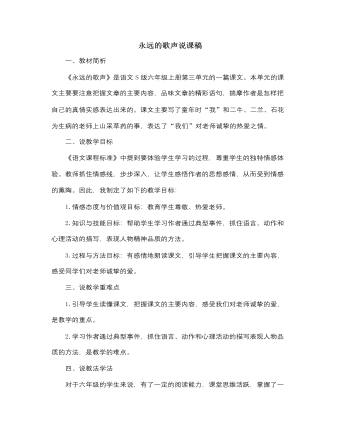
人音版小学音乐三年级下册永远的歌声说课稿
五、说教学过程为了完成本节课的教学目标,我设计了以下教学过程。1.激情导入,质疑课题首先,教师唱《小放牛》,以童年的歌声引入课文,激发学生的兴趣。同学们,走出山乡、走出童年已经很久了,真的很久很久了。童年像一幅褪了色的画,贴在记忆迷离的墙壁上,好些地方都淡得看不出线条和色彩来了,而童年的一些歌却如那山间淙淙的小溪,清亮亮地流淌着,至今仍想在我的耳边,我的耳边又响起了那永远的歌声。(板书课题:永远的歌声)接着,提出问题,为什么作者以“永远的歌声”为题?歌声里包含着什么?这两个问题也是本节课的主线,接下来的教学环节都将围绕这两个问题进行。2.初读课文,理清文章的脉络自由朗读课文,想一想课文主要讲述了一件什么事情?
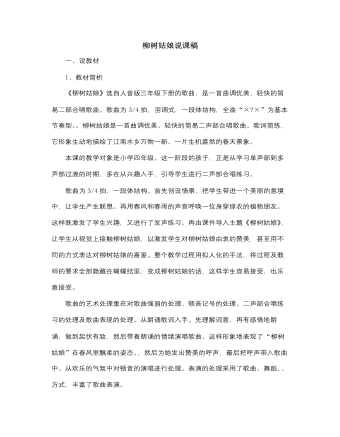
人音版小学音乐三年级下册柳树姑娘说课稿
设计意图:这是本课的重点内容。先让学生装扮风雨声赞美柳树,在这个过程中学会歌曲旋律.采用打击乐器或小手为歌曲伴奏,使学生更生动的表现歌曲的美感,丰富了审美体验。让学生在听、读、唱、动等情感体验活动中感受音乐、欣赏音乐和表现音乐。③学唱二声部设计意图:学生在学会歌曲后,欣赏录音注意二声部进入的位置,让学生先唱一声部,教师示范唱二声部.然后利用多种形式进行合唱练习。让学生感性认识音乐要素变化,在音乐中起到的作用,增加了知识性和趣味性,同时达到巩固歌曲的目的。6、律动表演,情感升华。在教学的尾声教师创设教学情景,启发学生植树,请两位同学模拟植树场景,其余的学生以他们为中心围成圆圈,用最好听的歌声和最优美的动作来祝福小树苗快快长高。设计意图:这是本课情感态度价值观目标的拓展。通过课堂上的植树活动,潜移默化地教育学生“爱护树木,关注环保”,从我做起,从现在做起。

人音版小学音乐三年级下册甜甜的秘密说课稿
歌曲处理部分我采取了对比式的教学方法,由于此曲有两遍“悄悄地、悄悄地、悄悄地”,而前后两遍的旋律是有变化的,相似之中又有不同之处,在演唱过程中我单独拿出这两个旋律进行视唱对比,让学生自主听辨,这样帮助孩子更好、更准确的演唱。这一环节我主要采取探究式和对比式两种教学方法。我的第四环节是“动”情——感动之情,首先在欣赏前我把老师比作米兰,然后提出疑问“为什么把老师比作米兰而不是蜡烛、春蚕呢?”让孩子们在歌曲中找到答案。孩子们聆听这首歌曲后,我问学生“你把老师比作什么?为什么呢?”探索学生的心声,然后在师与生的相互探讨中让孩子们懂得一支粉笔写就人生的轨迹;两鬓染霜谱成人生绚丽的乐章;三尺讲台留下人生的灿烂和辉煌!这就是我们可敬的老师。最后我朗诵了一首配乐诗朗诵歌颂老师,让孩子和我的心中都漾起那份沉甸甸的师母般的爱。
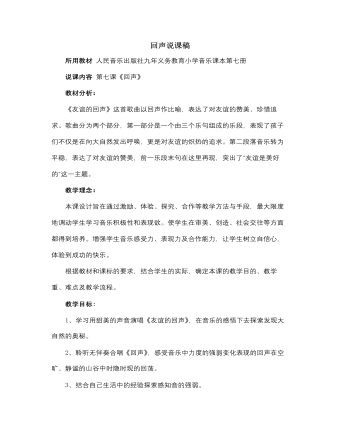
人音版小学音乐四年级下册回声说课稿
①教师范唱歌曲旋律。②随教师轻声视唱歌曲的旋律。③随琴演唱歌曲的旋律。5、学习歌词:①把歌词以诗歌的形式展现出来,请一名同学有感情地朗读歌词。②全体学生按女声、男声、合这一要求朗读歌词。[设计意图:注重音乐与相关学科的整合,帮助学生提高理解音乐、表现音乐的能力。]6、随音乐轻声填词。7、完整演唱歌曲。8、问:为什么称“友谊的回声”?这首歌曲以回声作比喻,表达了对友谊的赞美,同时告诉我们要珍惜身边的友谊。四、扩展升华1、问:除了回声部分有力度变化外,还可以根据歌词加入哪些力度变化呢?[设计意图:让学生根据自己对歌曲及力度变化的理解,为歌曲加入适当的力度记号,鼓励学生对音乐有独特的见解,激发学生创作的兴趣,培养学生的音乐鉴赏能力。]
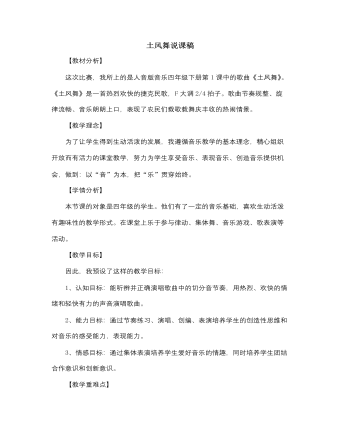
人音版小学音乐四年级下册土风舞说课稿
通过观察比较,让学生发现歌谱中的力度记号,如:重音、渐强、渐弱记号等,从而跟好的演唱歌曲,提高学生的审美能力。四、创编表演,体验情感通过视频让学生了解土风舞的舞蹈动作特点,再由小组讨论创编,为我们今天所学唱的歌曲创编出属于自己的土风舞动作。此环节的进行,让全体学生都能参与到音乐实践当中,让学生能自信地唱、大胆地编、尽情地演,感受音乐带给人们无比的快乐,学生的主体性和创造性得以充分的体现。五、总结评价,收获快乐本课的教学评价我是以表扬和鼓励为主,随时引导学生在音乐活动中开展自评互评和老师的随堂评价,以提高学生的乐感和审美能力。我评价他们的重点是能否积极自信的参与音乐表现、能否与其他的同学协作配合、在课堂小结时我还安排了学生谈一谈这节课的感想如:这节课你学到了什么?你觉得自己今天表现的怎么样?
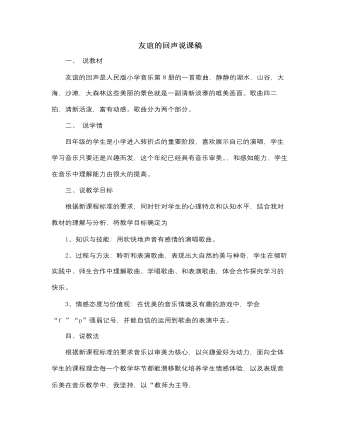
人音版小学音乐四年级下册友谊的回声说课稿
2、学唱歌曲,解决难点:老师示范演唱让学生找出第一段和第二段的不同地方板书节奏切分音并让学生律动练习带领练习另一处回声,并认识练习前八分休止,对比八分音符练习一段段的教歌曲。3、表演歌曲,珍惜友谊。播放学生友谊的画面以及友谊的名言,进行情景教学,让学生带感情的演唱歌曲,加上回声动作,练习歌曲中第三段进行练习,提问歌曲中最美的回声是什么。 拓展交流:你们的友谊可以再歌声中交流,先用着对大自然的热爱朋友之间的友谊演唱歌曲(男女分角色演唱)。小结:友谊是一朵鲜花,只有在双方的浇灌下越开越美丽,元友谊的回声,永远飘荡在你们身边。说板书设计:在本课教学中,我会利用多媒体的教学资源,把握所教的内容以PPT的形式展现,避免单一的教学模式,在关键处时,我会板书在黑板上
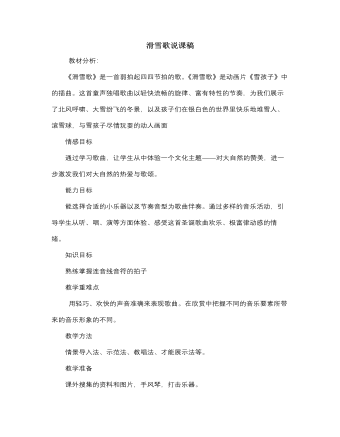
人音版小学音乐六年级下册滑雪歌说课稿
教材分析:《滑雪歌》是一首弱拍起四四节拍的歌。《滑雪歌》是动画片《雪孩子》中的插曲。这首童声独唱歌曲以轻快流畅的旋律、富有特性的节奏,为我们展示了北风呼啸、大雪纷飞的冬景,以及孩子们在银白色的世界里快乐地堆雪人、滚雪球,与雪孩子尽情玩耍的动人画面情感目标通过学习歌曲,让学生从中体验一个文化主题——对大自然的赞美,进一步激发我们对大自然的热爱与歌颂。能力目标能选择合适的小乐器以及节奏音型为歌曲伴奏。通过多样的音乐活动,引导学生从听、唱、演等方面体验、感受这首圣诞歌曲欢乐、极富律动感的情绪。知识目标熟练掌握连音线音符的拍子教学重难点用轻巧、欢快的声音准确来表现歌曲。在欣赏中把握不同的音乐要素所带来的音乐形象的不同。教学方法
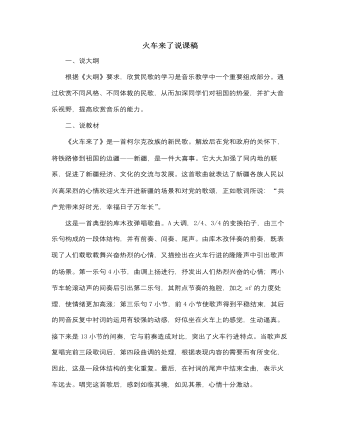
人音版小学音乐六年级下册火车来了说课稿
1、视觉图象法:少数民族的风土人情对我们汉族的孩子来说不那么了解。为了使他们更直接地了解到新疆柯尔克孜族人们的生活习惯,我运用电脑软件制作了一些柯尔克孜族的风情画面,给学生视听结合,避免枯燥的说教形式,使本来抽象的 内容变得具体形象化。2、对比欣赏法:在了解这个民族的风土人情时,我运用画面表格形式将新疆几个民族的人物作对比,从而使学生更清楚的了解这个民族的风土人情、歌曲特点。在教学中我还运用了创设情景、兴趣引入法、感性到理性等方法 。音乐家修海林认为“音乐审美必须要求体验到音乐的意境”,在这一课,我充分运用了多媒体教学手段,尽量让学生体验到音乐的意境,从屏幕上看到新疆的风土人情关系,听到新疆民歌不同的风格特点。
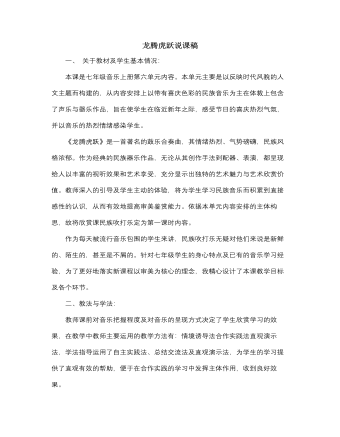
人音版小学音乐六年级下册龙腾虎跃说课稿
聆听感悟—本环节是模式实施的重要环节,也是围绕新课程理念提高审美,落实教学目标的关键。在此,从学生学习的角度出发,又细化为三个步骤具体实施:1、初步感知2、深入体验3、复听感悟。这三个步骤的实施目的在于,使得学生对于音乐的体验和感悟呈现出一个由表及里循序渐进的过程。先是使学生获得初浅的整体印象,再由教师精心选择设计特色音乐片段共同聆听体验,并引导启发学生感悟音乐,使学生逐步积累一些欣赏音乐的知识,有意识地将听觉、音乐理论及自身感悟巧妙融合,形成学习和鉴赏的基本方法,从而提高对于音乐的感悟和鉴赏能力。其中复听感悟环节往往会受到乐曲篇幅及时间所限制,如本课《龙腾虎跃》一曲,如果完整欣赏一次需八分多钟的时间,因此,考虑到学生学习民乐的经验和实际情况,故作调整:将总体感悟乐曲放到第二课时进行。
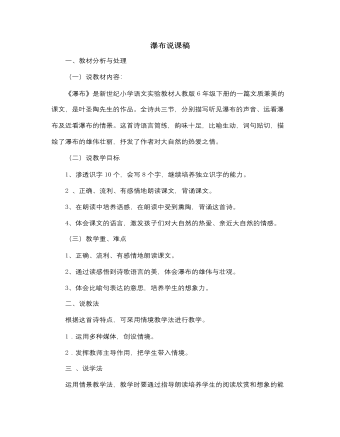
人音版小学音乐六年级下册瀑布说课稿
4、读第3小节。加快脚步,我们现在站到了瀑布的脚下。又看到了什么?自己读,想想瀑布又是怎样的?指名说。(示图)分别指导读好这两个句子。男女合作读这一小节。[这一段的学习,先引导学生想象,发展学生想象力;再适当运用多媒体,提升孩子的感悟,升华情感,引导孩子达到学文、入情的高潮。](四)以读代讲 情感升华瀑布多么美呀!再读,你会更加感受到它的美。下面我们随着动人的音乐,一起美美地读一读这首优美的诗歌吧!配乐齐读。大自然中还有很多象庐山瀑布这样美丽的风景,利用空闲时间,请你走进大自然,去欣赏更多的美景吧!(五)作业1、背诵小诗。(全体都完成)2、如果你愿意,画一画你亲眼见到的或者从电视等其他地方看到的瀑布,为它配上一首自己写的小诗。(自主选择)
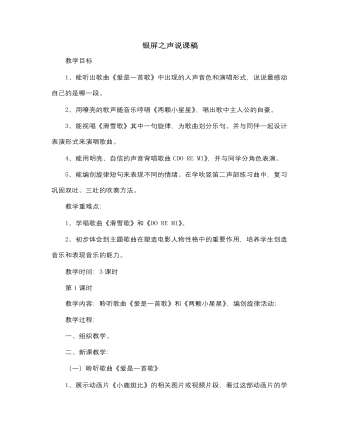
人音版小学音乐六年级下册银屏之声说课稿
2、初听歌曲,听出歌曲中出现的人声音色和演唱形式。聆听前,教师与学生一起回顾人声的分类和学过的演唱形式有哪些,并把这些知识写在黑板上,便于学生在聆听时对照。歌曲先是由男声领唱,接着是男女声合唱。3、复听歌曲,听后让学生说说歌中的哪一段最能感动自己。引导学生从歌名和歌词中谈谈对歌曲的理解,结合歌曲的演唱形式“领唱与合唱”所体现的效果,体会歌曲最令人感动的部分。4、再次聆听,感受歌曲所表达的甜美与温馨。(二)聆听歌曲《两颗小星星》1、从复习演唱歌曲《小小少年》人手,简单回忆德国影片《英俊少年》的故事情节,并让学生谈谈对主人公海因切的印象。2、初听歌曲,,感受歌曲的情绪。教师引导学生从歌曲的节奏型与一字一音中,感受主人公海因切的自信与自豪的性格特点。还请学生听出不同情绪的两个乐段,为后面编创活动做铺垫。
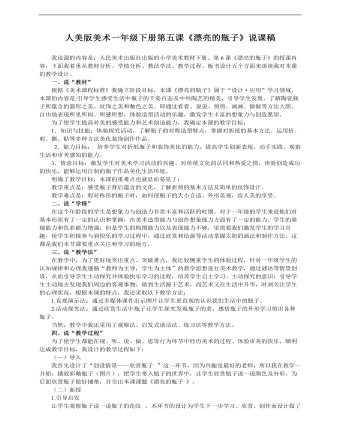
小学美术人美版一年级下册《漂亮的瓶子》说课稿
1.知识与技能:体验探究活动,了解瓶子的对称造型特点,掌握对折纸的基本方法。运用折、剪、撕、贴等多种方法美化装饰创作作品。 2.能力目标: 培养学生对折纸瓶子和装饰美化的能力,提高学生创新表现、动手实践、观察生活和审美感知的能力。3.情意目标:激发学生对美术学习活动的兴趣、对传统文化的认同和热爱之情,体验创造成功的快乐,能够运用自制的瓶子作品美化生活环境。明确了教学目标,本课的重难点也就显而易见了:教学重点是:感受瓶子背后蕴含的文化,了解折剪的基本方法及简单的纹饰设计。教学难点是:剪对称形的瓶子时,如何使瓶子的大小合适、外形美观,给人美的享受。
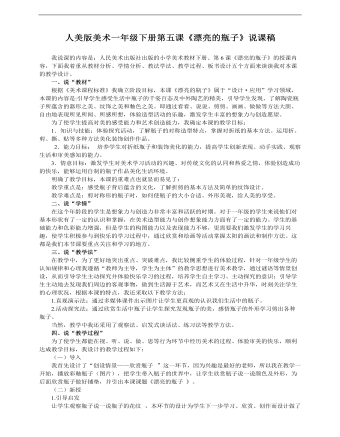
小学美术人美版一年级下册《6漂亮的瓶子》说课稿
1.知识与技能:体验探究活动,了解瓶子的对称造型特点,掌握对折纸的基本方法。运用折、剪、撕、贴等多种方法美化装饰创作作品。 2.能力目标: 培养学生对折纸瓶子和装饰美化的能力,提高学生创新表现、动手实践、观察生活和审美感知的能力。3.情意目标:激发学生对美术学习活动的兴趣、对传统文化的认同和热爱之情,体验创造成功的快乐,能够运用自制的瓶子作品美化生活环境。明确了教学目标,本课的重难点也就显而易见了:教学重点是:感受瓶子背后蕴含的文化,了解折剪的基本方法及简单的纹饰设计。教学难点是:剪对称形的瓶子时,如何使瓶子的大小合适、外形美观,给人美的享受。

人音版小学音乐三年级下册嘀哩嘀哩说课稿
艺术课程作为一门新课程,是在已有的音乐、美术分科基础上构建的一门新课程,从传统的分科教学转变为多门艺术学科的沟通和融合。本课是从音乐切入的艺术课,让学生在欣赏、节奏、歌唱、表演等一系列音乐活动中感受音乐,学习音乐,表现音乐。让孩子们在歌唱描述春天的歌曲中体验春天的美丽景色;并综合了音乐、美术、舞蹈等艺术形式和表现手法,全面地培养学生的综合能力,使艺术课堂教学呈现勃勃生机,充分反映了课程改革的新理念。二、说教材1.教材分析歌曲《嘀哩嘀哩》是一首深受孩子们喜爱的歌曲,它反映的是少年儿童通过观察大自然的变化,寻找春天的足迹、迎接春天的到来。它以儿童天真、活泼的语气歌唱美丽的春天,抒发心中无限欢乐的感情。《嘀哩嘀哩》又是学生非常熟悉的一首歌曲,有的学生已经会唱,他们对音乐的理解与把握也有一定的能力。针对这首歌曲,最主要的就是运用孩子们感兴趣的方式帮助学生准确的演唱歌曲“嘀哩哩嘀哩嘀哩哩”有难度的乐句。
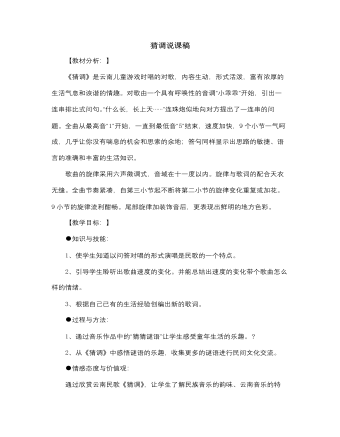
人音版小学音乐三年级下册猜调说课稿
4、再听歌曲。(了解歌词内容)师:待会儿听清楚谜面的同学请举手示意一下。(利用多媒体课件,给学生播放歌词中所演唱的内容,文字与图片相结合)教师与学生一起分析歌词内容。(有问有答的谜语)师:对,以问答对唱形式演唱歌曲是民歌的一个特点。5、请学生小声随音乐哼唱歌曲旋律。6、用打击乐器为歌曲伴奏。(四)拓展教学。(10分钟)1、创编歌词。(意图:进一步了解一问一答的对歌演唱形式)师:我们现在一起来用谜语创编出新的的歌词,保持歌曲原有的节奏与结构。(学生分组创编,之后分组展示。)(教师可做一定的提示,教师给出谜底,请学生编出谜面来。)2、了解云南。(意图:通过了解云南歌舞、风俗,让学生有更广阔的视野,更加了解民族文化、了解民族音乐)师:云南的民歌不仅好听,那里的自然景色、人们的舞蹈都很美!

